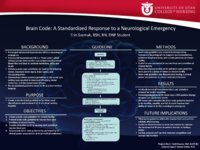The Graduate Nursing Project collection includes Doctor of Nursing Practice (DNP) Scholarly Projects and Master's students' non-thesis projects submitted as part of program requirements.
TO
Filters: Relation Is Part Of: "Graduate Nursing Project, Doctor of Nursing Practice, DNP" Collection: "ehsl_gradnu" Subject: "Time-to-Treatment"
1 - 25 of 11
| Title | Creator | Date | Description | Relation Is Part Of | ||
|---|---|---|---|---|---|---|
| 1 |
 |
Difficult Urinary Catheter Navigation Guidelines | Stromness, Lori | 2019 | Background: Knowledge, confidence, and proficiency are paramount for patient safety during urinary catheter (UC) placement, especially when placement becomes difficult. Placement is difficult when the first attempt is not successful. Nurses encountering difficult UC placements are left to try again,... | Graduate Nursing Project, Doctor of Nursing Practice, DNP |
| 2 |
 |
Initiative for Appropriate Antibiotic Prescribing Practices in the Emergency Setting | Nye, Jace | 2019 | The overuse and misuse of antibiotics has been a health concern for years and effects people all over the world. While improvements have been made in antimicrobial stewardship, progress continues to be slow in preventing inappropriate prescriptions. There remains a need to assess and improve antimic... | Graduate Nursing Project, Doctor of Nursing Practice, DNP |
| 3 |
 |
Recognize and Treat Intracranial Hypertension to Improve the Quality of Patient Outcomes Who are Treated in the Neuro Critical Care Unit | Bentley, Kristy | 2018 | Background Treating intracranial hypertension (IH) and brain herniation quickly and effectively is imperative in reducing morbidity and mortality. Local Problem The Neuro Critical Care Unit (NCCU) at Intermountain Medical Center (IMC) is considered the leader within Intermountain Health Care (IHC) i... | Graduate Nursing Project, Doctor of Nursing Practice, DNP |
| 4 |
 |
Cervical Collar Removal Times at a Level 1 Trauma Center: A Needs Assessment | Teas, Amelia H. | 2018 | Trauma patients remain in cervical collar neck braces for up to 12 hours awaiting final radiology readings. These final readings are necessary before the collar can be removed. The extended wearing of cervical collars potentially leads to worsening fractures, ligamentous injury, increased spinal mov... | Graduate Nursing Project, Doctor of Nursing Practice, DNP |
| 5 |
 |
Timely and Safe Removal of Backboards in a Rural Emergency Department | Garrett, Craig | 2018 | This study explored the need for timely and safe removal of backboards in a rural emergency department where no guidelines or protocols were currently in place for patients being brought in on backboards. Studies indicate adverse effects on patients who are allowed to have prolonged backboard time b... | Graduate Nursing Project, Doctor of Nursing Practice, DNP |
| 6 |
 |
Neurologic Monitoring of Neonates | Messick, Jennifer R. | 2017 | POSTER | Graduate Nursing Project, Doctor of Nursing Practice, DNP |
| 7 |
 |
Brain Code: A Standardized Response to a Neurological Emergency | Szemak, Erin | 2017 | POSTER | Graduate Nursing Project, Doctor of Nursing Practice, DNP |
| 8 |
 |
Neurologic Monitoring of Neonates in the Neonatal Intensive Care Unit | Messick, Jennifer R. | 2017 | The American Clinical Neurophysiology Society has identified neonates at high risk for neurologic sequelae. These clinical conditions include: hypoxic ischemic encephalopathy, neonatal seizures, significant intraventricular hemorrhage, neonates placed on extracorporeal membrane oxygenation, central ... | Graduate Nursing Project, Doctor of Nursing Practice, DNP |
| 9 |
 |
Delayed Antibiotic Prescribing in Primary Care | Laack, Jessie | 2017 | Prescribing antibiotics for self-limiting upper respiratory infections is unfortunately common practice among primary care providers (PCP) in the US. Inappropriate use of antibiotics leads to the formation of resistant organisms, which have been increasing worldwide. Delayed antibiotic prescribing (... | Graduate Nursing Project, Doctor of Nursing Practice, DNP |
| 10 |
 |
Brain Code: A Standardized Response to a Neurological Emergency | Szemak, Erin | 2017 | Intracranial hypertension (IH) is a neurological emergency that can lead to profound disability and death and is consequently referred to as a brain code. Intracranial hypertension is the sequelae of typical acute care diseases or injuries such as stroke, traumatic brain injuries (TBIs), and hepatic... | Graduate Nursing Project, Doctor of Nursing Practice, DNP |
| 11 |
 |
Implementing a Fast Track | Burton, Kassie | 2016 | Over the past 10 years there has been an increase in the number of emergency room visits. From 1993 to 2013 the number of Emergency Departments in the United States has dropped by more than 500 (AHA, 2013). These changes have caused an increasing overcrowding problem; many researchers have categoriz... | Graduate Nursing Project, Doctor of Nursing Practice, DNP |
1 - 25 of 11
